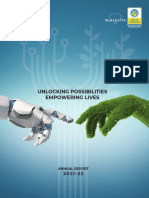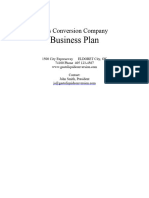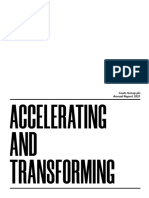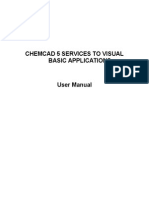Time Technoplast Limited Report
Time Technoplast Limited Report
Uploaded by
serisop424Copyright:
Available Formats
Time Technoplast Limited Report
Time Technoplast Limited Report
Uploaded by
serisop424Copyright
Available Formats
Share this document
Did you find this document useful?
Is this content inappropriate?
Copyright:
Available Formats
Time Technoplast Limited Report
Time Technoplast Limited Report
Uploaded by
serisop424Copyright:
Available Formats
Time Technoplast Limited
History of the company:
Time Technoplast is engaged in the business of Industrial packaging, PE pipe
Manufacturing and Manufacturing of Type IV composite cylinders over the years
the company has achieved market leadership in both domestic as well as in global
markets. The company manufactures diverse products in the industrial packaging
segment like IBC containers, MOX films, Plastic Drums, Jerry cans, Fuel Tanks,
Urea tanks, LPG, CNG & Oxygen composite cylinders and more.
Brief History
The company has not performed well in the past due to poor capital allocation
decisions, aggressive debt and capex expansion, volatility in raw material prices and
decreased management bandwidth. The company expanded heavily into different
products like battery management, home plastic furniture etc. which diverted
managements focus.
Our Rationale for the pick
1. The company has made Mr. Bharat Vageria as there chairman and MD and this
has changed many things for the company and also improved the companies
focus towards value added products and focus on better return ratios for the
company.
2. The company in the past used to over promise and under deliver in terms of
numbers and return ration but now that had significant impact on the market
perception of the company.
3. Technologically sound company with strong R&D team which is evident from
products of the company and the company is the world’s fourth largest
industrial packaging company in the world and commands 70-80% market
share in the Indian market, the companies is market leader in 9 out 11 countries
in which it does business and the company’s composite cylinder is accepted
and approved in 48 countries of the world.
4. The company has changed its focus towards value added composite product
from the traditional industrial packaging business which is evident from the
change in it revenue mix the new composite products are high margin business
which enjoys margin of 18-22% as compared to 10-12% margin traditional
business.
5. The company is the first company in India to manufacture CNG composite
cylinder which is the latest technology available for CNG composite cylinder. There
are several benefits of the product such as it blast free, 70% less heavy then the
traditional steel cylinders. The market size for CNG composite cylinder is of 11,453
crores and the company has the highest installed capacity of 480 cascades (600
cascaded will be added by Nov 2024) making total installed capacity to 1080
cascades.
6. The gas distribution companies has also shown interest in type 4 cylinders which
is evident from the recent tenders rolled out but the CGD companies and the
company is also poised to gain business from the government vision of establishing
10,000 CNG gas stations by 2027 as every CNG gas station requires minimum 2
cascades and there are 60 Cylinders in one cascade taking total requirement to
6,00,000 cylinders and cost of one cascade is 33 to 45 lakhs taking total demand of
up to 9000 crores.
7. Improved focus of the company is evident from the latest announcement of
divesting 50% of its MENA region subsidiary and raising 25 Million USD of
funding and divesting 125 crores worth Non – core assets and closing down of home
hard plastic furniture division and from the proceeds company want to use the sum
for debt repayment and for benefit of the shareholders (possibly buyback or
dividend)
8. Capacity utilization levels of the company has also significantly improved over
the last two years to 82% and the companies LPG type 4 Cascade capacity is 90%
booked and CNG cascade capacity is also operating at 85-90% capacity.
9. The company is expanding slowly into becoming a composite product company as
the new expansion is coming in the composite product category and the company is
also expanding itself to make hydrogen cylinders and retro fitting as well as OEM
CNG type 4 Cylinders (the size of the opportunity can be gauged by looking at the
CNG cars registration per month has risen to 75,000 cars from 30,000 to 45,000 in
pre covid times)
Analysis of retrofitting market
The company is looking to expand itself into retrofitting as well as OEM compressed
CNG cylinder market. The cost to convert an existing petrol / diesel vehicle into
CNG is estimated to be around 3,00,000 per vehicle and the estimated savings in
running cost is 2.64 per kilometer so if as the By 2026 it is estimated that there will
be 85,000 CNG buses in India so the opportunity size comes close to 3,330 crores.
LPG Cascade Business
The company is also engaged into manufacturing type 4 LPG cascade and is one of
the largest producer in the country. The company has an installed capacity of 1.4
million cylinders but effectively on 1 million cylinders can be made due to different
sizes of cylinders are manufactured, the company has received order from IOCL to
supply 7,50,000 type 4 composite cylinders and IOCL has also extended the order
for one more time this order consumes 70% of total installed capacity of the
company and company has plans to expand LPG business but it will expand when
other two OMC also roll out there tenders.
The segment is operating at 90%+ capacity and the remaining is exported and
company has received approval from more than 48 countries in the world.
Bharat Ji’s outlook for international business consolidation
Pricing Structure of the company and how they control raw material
prices.
Opportunity in CNG cascade Business
Shift in managements intent becomes more clear
Risk Concerns for the company
1. The company historically suffered from poor capital allocation decisions which
includes aggressive capital expansion and aggressive debt increase that lead to
mishap in the balance sheet and when the there was slump in the market
demand the debt burden lead to margin pressure on the company.
2. The company did not manage to watch the talk and walk the guidance provided
which lead to decreased investor confidence.
3. The company tried to do many things in past like tried to venture into real
estate, Battery manufacturing, home furniture molding which lead to decrease in
management bandwidth leading to decreased focus and in turn the whole
business suffered.
4. The company uses High density polymer as its raw material which exposes it to
further raw material volatility and secondly it is imported by the company it
further exposes it to currency volatility and due to which company is in need to
carry high inventory which leads to stretched working capital cycle
5. The company’s PE pipe business has turned around but has to look out because
of volatility in its revenue generation capability.
Guidance of the management
1. Revenue mix to be 40% value added products and 60% established products
2. Revenue of 500 crores by FY24 from CNG business and 800 crores by FY 25
3. ROCE target of 19%+ by FY 25-26 and margins in the range of 18%
4. Estimated revenue of 2000 crores plus from composite cylinders in five years
time
5. 600 cascade capacity will be commercialized by Q1FY25
6. To reduce working capital cycle to 90 to 100 days by FY25
7. To divest all non core assets by FY25 and in CY the company will repay 100
crores in debt and target to half the debt from the proceeds of restructuring
activity
Key performance indicator identified
1. Business mix between value added and established products and see whether it
is increasing or not?
2. Volume and revenue contribution from cascade product to look out for
3. Divestment and restructuring progress should be closely tracked along with
margin improvement plus, debt reduction programme.
ANNEXURE
Yearly Segmental Performance and key metrics
Quarterly Segmental Performance and key metrics
Revenue Mix of the company & Capital Expenditure of the Company
Share FY 16 FY 17 FY 18 FY 19 FY 20 FY 21 FY 22 FY 23
Established Products 88% 87% N.A. 71% 71% 70% 69% 67%
Composite Products 12% 13% N.A. 29% 29% 30% 31% 33%
2023-24
CAPEX 2017-18 2018-19 2019-20 2020-21 2021-22 2022-23
Till now
Established Products 118.9 171.3 94.4 67 78.5 86.6 62.6
Value Added Products 122.7 58.4 51 36.5 107.2 136.9 81.6
% Capex in Established Products 49% 75% 65% 65% 42% 39% 43%
% Capex in Value Added Products 51% 25% 35% 35% 58% 61% 57%
Total 241.6 229.7 145.4 103.5 185.7 223.5 144.2
It is clearly visible that the new leadership is walking the talk and if focused to
increase the mix of value added composite product in the total revenue mix which
will in turn improve margin and will lead to shift in time techno being recognized as
traditional plastic company to value added composite player will lead to rerating of
the company.
Poor Capital Allocation Problem can be highlighted by the following table:
Change in Dividend
Particulars
Borrowings Paid
2012 - 14
2013 56 11
2014 36 12
2015 -57 12
2016 -58 13
2017 -24 14
2018 55 18
2019 63 23
2020 50 25
2021 -27 22
2022 43 17
2023 -15 23
Sep-24 -26
Total 96 204
You might also like
- Mohamed Fawzy PortfolioDocument65 pagesMohamed Fawzy PortfolioAnonymous IygQooNo ratings yet
- Forecasting Accuracy and Cognitive Bias in The Analysis of Competing HypothesesDocument81 pagesForecasting Accuracy and Cognitive Bias in The Analysis of Competing HypothesesKristan J. Wheaton100% (2)
- of Prince Pipes EditedDocument17 pagesof Prince Pipes Editedabhimodi0608No ratings yet
- Reliance Industries Fundamental PDFDocument6 pagesReliance Industries Fundamental PDFsantosh kumariNo ratings yet
- New-Year-Picks-2025Document17 pagesNew-Year-Picks-2025sharmaansshumanNo ratings yet
- Module B Dec 2016questionDocument9 pagesModule B Dec 2016questionConnieChoiNo ratings yet
- Kiri Industries Report With ValuationDocument6 pagesKiri Industries Report With ValuationDishant ShahNo ratings yet
- Financial FeasibilitysampleDocument14 pagesFinancial FeasibilitysampleBig4 AdsNo ratings yet
- DG Khan Cement Final Report AreebDocument23 pagesDG Khan Cement Final Report AreebAreeb AsifNo ratings yet
- Engineers India 5321780316Document234 pagesEngineers India 5321780316eepNo ratings yet
- Pricol Limited - Broker Research - 2017 PDFDocument25 pagesPricol Limited - Broker Research - 2017 PDFnishthaNo ratings yet
- RELIANCE - Investor Presentation - 06-May-22 - TickertapeDocument70 pagesRELIANCE - Investor Presentation - 06-May-22 - TickertapeAhaana guptaNo ratings yet
- HTTPSWWW - bharatpetroleum.inpdfOurFinancialBPCL20Annual20Report Final 05-08-22.PDF 3Document436 pagesHTTPSWWW - bharatpetroleum.inpdfOurFinancialBPCL20Annual20Report Final 05-08-22.PDF 3Rudransh narangNo ratings yet
- Comparison Between The 2 Coglomorate of AustraliaDocument11 pagesComparison Between The 2 Coglomorate of Australiahbutt050No ratings yet
- BPCL Annual Report Final 05-08-22Document436 pagesBPCL Annual Report Final 05-08-22Shrikant BudholiaNo ratings yet
- Choice April'21Document7 pagesChoice April'21RajatNo ratings yet
- Swot Analysis On CollgateDocument12 pagesSwot Analysis On CollgateS.S.Rules100% (1)
- EIL Annual Report 2019-20 Shareholder Eng PDFDocument308 pagesEIL Annual Report 2019-20 Shareholder Eng PDFgauravkrastogiNo ratings yet
- SFM Cia 1Document13 pagesSFM Cia 1thememeswala7546No ratings yet
- 2017 Prabhat Investor Presentation For q1 Fy 17Document31 pages2017 Prabhat Investor Presentation For q1 Fy 17goyal.rohit8089No ratings yet
- Initiating Coverage - Expleo Solutions - 050822Document19 pagesInitiating Coverage - Expleo Solutions - 050822rathore400No ratings yet
- Chairman Address 25.09.2023Document4 pagesChairman Address 25.09.2023PUJA GUINNo ratings yet
- Equatorial Gas Conversion Company GCCDocument18 pagesEquatorial Gas Conversion Company GCCaustinoyugi08No ratings yet
- Annual Report 2006-07 HPCLDocument164 pagesAnnual Report 2006-07 HPCLnishantNo ratings yet
- Meghmani Organics Ltd. Corporate Presentation Februray 2021 (1)Document43 pagesMeghmani Organics Ltd. Corporate Presentation Februray 2021 (1)kanjisathvara309No ratings yet
- Vikas Ecotech LTDDocument6 pagesVikas Ecotech LTDbediNo ratings yet
- Initiating Coverage - Gulf Oil Lubricants India Ltd. - 290822Document17 pagesInitiating Coverage - Gulf Oil Lubricants India Ltd. - 290822dbi003lavrajNo ratings yet
- Working Capital Management of Heidelberg Cement Bangladesh Limited (HCBL)Document28 pagesWorking Capital Management of Heidelberg Cement Bangladesh Limited (HCBL)Farshid ChowdhuryNo ratings yet
- Sample Business PlanDocument16 pagesSample Business PlanNazrinNo ratings yet
- Cost Management Hero MotoCorpDocument6 pagesCost Management Hero MotoCorpNiraj AgarwalNo ratings yet
- Greaves CottonDocument11 pagesGreaves CottonMahesh Karande (KOEL)No ratings yet
- Eicher Motors Ltd.Document11 pagesEicher Motors Ltd.ANNA VARUGHESE 2128034No ratings yet
- Ar08052012rDocument220 pagesAr08052012rSneha DaswaniNo ratings yet
- Ambani OrganicsDocument3 pagesAmbani OrganicsSam vermNo ratings yet
- SFAD Final Term Report.Document15 pagesSFAD Final Term Report.Mansoor ArshadNo ratings yet
- BEML Annual Report - FY 2021-2022Document281 pagesBEML Annual Report - FY 2021-2022NILESH SHETENo ratings yet
- PG and Tvs ReportDocument15 pagesPG and Tvs ReportSAYALEE MESHRAMNo ratings yet
- AGI GreenpacDocument2 pagesAGI GreenpacdevidannidhiNo ratings yet
- 243386Document22 pages243386shujaat888No ratings yet
- DG Khan Cement Areeb-2Document20 pagesDG Khan Cement Areeb-2Areeb AsifNo ratings yet
- RilDocument220 pagesRiljainsasaNo ratings yet
- PTTGCDocument40 pagesPTTGCsozodaaaNo ratings yet
- HSL - IC - Gujarat Themis Biosyn - 02012023Document12 pagesHSL - IC - Gujarat Themis Biosyn - 02012023Prasad NawaleNo ratings yet
- VIP Industries Q1FY21: Brief Company IntroductionDocument3 pagesVIP Industries Q1FY21: Brief Company IntroductionSam vermNo ratings yet
- Confidence 1Document6 pagesConfidence 1SiddharthNo ratings yet
- Pitti Engineering LTD - Company Update - 07062024 - 07-06-2024 - 10Document7 pagesPitti Engineering LTD - Company Update - 07062024 - 07-06-2024 - 10Shyam SundarNo ratings yet
- Coats Annual Report 2021Document212 pagesCoats Annual Report 2021dyotamarketNo ratings yet
- "Working Capital": A Project Report On GNFCDocument13 pages"Working Capital": A Project Report On GNFCEr Priti SinhaNo ratings yet
- SMSG Project ReportDocument48 pagesSMSG Project Reportthisiskaushik25No ratings yet
- Corporate Insights Weekly Update November 4-11, 2024Document12 pagesCorporate Insights Weekly Update November 4-11, 2024svbmail4uNo ratings yet
- Corporate Finance - IIDocument18 pagesCorporate Finance - IIMadhuram SharmaNo ratings yet
- Diageo PLC Balance ScorecardDocument9 pagesDiageo PLC Balance Scorecardsakhimhatre1011No ratings yet
- Course - 307, LINDEBD VALUATION REPORT PDFDocument26 pagesCourse - 307, LINDEBD VALUATION REPORT PDFFarzana Fariha LimaNo ratings yet
- Mid Cap Report NewDocument12 pagesMid Cap Report NewchinacatNo ratings yet
- Accounts FinalreportDocument19 pagesAccounts Finalreportsrishtidutta1924No ratings yet
- New Project FinalDocument13 pagesNew Project FinalHooria NadeemNo ratings yet
- Scmpe Compiler 2.0 CA Final New by CA Ravi AgarwalDocument481 pagesScmpe Compiler 2.0 CA Final New by CA Ravi AgarwalDebkumar PalNo ratings yet
- Khawaja Fareed University of Engineering and Information Technology Rahim Yar KhanDocument20 pagesKhawaja Fareed University of Engineering and Information Technology Rahim Yar Khanazuha3010No ratings yet
- A Study of the Supply Chain and Financial Parameters of a Small BusinessFrom EverandA Study of the Supply Chain and Financial Parameters of a Small BusinessNo ratings yet
- Policies to Support the Development of Indonesia’s Manufacturing Sector during 2020–2024: A Joint ADB–BAPPENAS ReportFrom EverandPolicies to Support the Development of Indonesia’s Manufacturing Sector during 2020–2024: A Joint ADB–BAPPENAS ReportNo ratings yet
- TREZ492 ExtrasAG PDFCLI 5484130 XML SIGNED 01022023h1729Document1 pageTREZ492 ExtrasAG PDFCLI 5484130 XML SIGNED 01022023h1729Ionut PatrasNo ratings yet
- Makalah: ModalDocument12 pagesMakalah: ModalDumaria Hotma Uli SitorusNo ratings yet
- Seminar 4Document2 pagesSeminar 4Jana Moataz Mohamed G02No ratings yet
- Service & Support: Support Packages For STEP 7 V11Document9 pagesService & Support: Support Packages For STEP 7 V11Grin GoNo ratings yet
- Word FormationDocument9 pagesWord Formationحسن محمد عبد الجبارNo ratings yet
- Korvet JSC ESP Wellhead Oct-2006Document3 pagesKorvet JSC ESP Wellhead Oct-2006pavel chernov100% (2)
- Print Ict 2 Reviewer Last TopicDocument3 pagesPrint Ict 2 Reviewer Last Topicinquiries.francisNo ratings yet
- 2 Evs Ae 2022-2023Document4 pages2 Evs Ae 2022-2023Parul SharmaNo ratings yet
- Account StatementDocument22 pagesAccount Statement18 Shivam SharmaNo ratings yet
- Perencanaan Penataan Lahan Pada Lahan Reklamasi Pt. Mega Multi Energi, Barito Utara, Kalimantan TengahDocument13 pagesPerencanaan Penataan Lahan Pada Lahan Reklamasi Pt. Mega Multi Energi, Barito Utara, Kalimantan Tengahatihana herpinaNo ratings yet
- (Anne Davis Basting) Forget Memory Creating Bette (BookFi)Document478 pages(Anne Davis Basting) Forget Memory Creating Bette (BookFi)VASCHOTI TRABANICONo ratings yet
- Fabric Cutter (Final)Document30 pagesFabric Cutter (Final)Puneet KaurNo ratings yet
- Design Brief - Convention Center 2020 PDFDocument4 pagesDesign Brief - Convention Center 2020 PDFNisam SubbaNo ratings yet
- Module 2 in Preparation and Evaluation of Instructional Materials Activity 1: Matrix For Available Learning Resources - DUE ON MARCH 28, 2020Document3 pagesModule 2 in Preparation and Evaluation of Instructional Materials Activity 1: Matrix For Available Learning Resources - DUE ON MARCH 28, 2020mynurse17No ratings yet
- 2024 ExhibitorsDocument76 pages2024 ExhibitorsMichael FranciscoNo ratings yet
- XFBDocument2 pagesXFBMikeCao1384No ratings yet
- BA023IU Project - Management - Syllabus 2021-22 Tue-ThuDocument7 pagesBA023IU Project - Management - Syllabus 2021-22 Tue-ThuHiếu Phan TrungNo ratings yet
- DOC132-Rev F-SterilContainer-System-CatalogDocument84 pagesDOC132-Rev F-SterilContainer-System-CatalogCristianNo ratings yet
- Chemcad 5 Services To Visual Basic ApplicationsDocument41 pagesChemcad 5 Services To Visual Basic ApplicationsFrancoNo ratings yet
- Manual Elspec SPG 4420Document303 pagesManual Elspec SPG 4420Bairon Alvira ManiosNo ratings yet
- Nfpa 72 2007 IndexDocument15 pagesNfpa 72 2007 Indexsaladin1977No ratings yet
- CCLS English Student Book Stage 7 AnswersDocument50 pagesCCLS English Student Book Stage 7 Answersanwarnadir993100% (2)
- Visio LCP 06Document21 pagesVisio LCP 06Mahmoud HossamNo ratings yet
- Triple S Truck Repair Jan 2019 To April 30 2020Document3 pagesTriple S Truck Repair Jan 2019 To April 30 2020sidhuNo ratings yet
- Tip Sheet: Functional Behavior Assessment and Function-Based InterventionsDocument8 pagesTip Sheet: Functional Behavior Assessment and Function-Based InterventionsMei MeiNo ratings yet
- Bhatia Battery Report-22223129Document24 pagesBhatia Battery Report-22223129Vaishnavi AroraNo ratings yet
- What Is A Thesis StatementDocument23 pagesWhat Is A Thesis StatementmdrafiurrahimrafiNo ratings yet
























































































